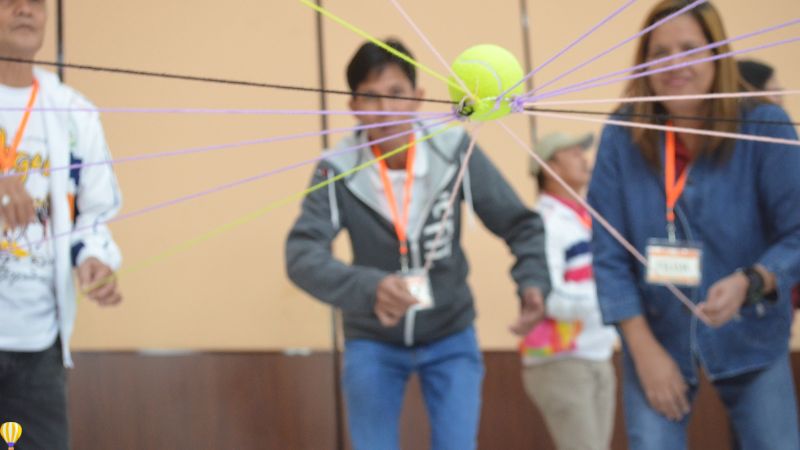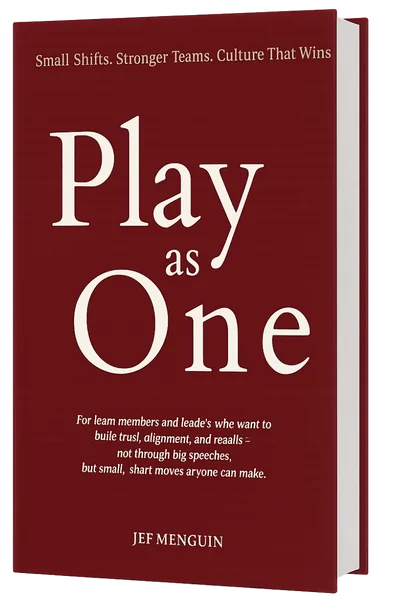They were all laughing. Matching shirts, loud music, balloon towers — the works.
The HR manager beamed as her team shouted “Go Team Vision!” while trying to pass a ball using only their elbows. Everyone clapped when they finished. Someone even cried laughing.
By all accounts, the day was a success.
But on Monday, nothing changed. The same miscommunication. The same silent resentment in meetings. The same people carrying the same load.
Sound familiar?
I’ve seen this scene a hundred times — teams having fun but not connecting. People smiling in photos, but not trusting each other more than before.
We call it team building, but often, it’s just team bonding — temporary, shallow, and easy to forget.
Play is powerful. But only when it’s done with purpose.
When play becomes an escape from work instead of a mirror for it, it entertains — but doesn’t transform.
This isn’t an argument against fun. It’s a call to take play seriously — to use it as a tool for engagement, honesty, and trust.
Fun alone doesn’t build teams. Meaning does.

From Escape to Engagement
Most team-building sessions are designed as an escape. A break from deadlines. A day to “recharge.”
There’s nothing wrong with that — people need rest. But if the only goal is to make everyone laugh, what happens when the music stops?
I once worked with a sales team that played a “build the tallest tower” game. They cheered, strategized, and celebrated. But afterward, when asked what the activity meant for their work, someone said, “Wala lang. Masaya lang.” (Nothing much. It was just fun.)
Compare that to another team I worked with — a logistics group in Cavite. Their play wasn’t about towers; it was about solving real delivery problems through a simulation. They role-played drivers, dispatchers, and clients. They laughed, argued, and adapted — and in the debrief, someone said, “Now I understand why our dispatchers get frustrated. We don’t listen enough.”
That’s the difference between escape play and engaged play.
Escape play gives a temporary high — a few hours of energy that fades once people return to real life. Engaged play, on the other hand, pulls work into the game. It creates safe space for people to face the same patterns that block them at work — blame, silence, ego — but in a lighter, more open way.
In escape mode, play is distraction. In engagement mode, play is discovery.
And that’s where real transformation begins — not in the fun itself, but in the meaning it helps us uncover.
When Play Fails
Let’s be honest. Not every game works. Sometimes, play backfires.
I’ve seen sessions where people roll their eyes, fake laughter, and check their phones during “energizers.” You can almost hear their thoughts: “Ano ba ‘to? Sayang oras.”
When play fails, it’s rarely because people are “killjoys.” It’s because something deeper isn’t right.
Here are three patterns I see again and again.
1. Forced Fun
When people are told to have fun, they won’t. You can’t command joy.
One facilitator I once observed shouted, “Come on! Louder! Feel the energy!” The group clapped louder, but their smiles froze. It became performance, not participation.
The problem? The activity was about pleasing the facilitator, not connecting as a team.
👉 Lesson: Play is powerful only when it’s chosen, not imposed. Create invitations, not instructions.
2. Disconnected Design
Some games are fun but meaningless. You can play “pass the message” or “human knot” all day, but if no one connects it to real team challenges — communication gaps, trust issues, accountability — it’s just motion without meaning.
I remember one company that spent thousands on a beach team-building weekend. People laughed hard, drank harder, and posted happy photos. But after a week, old conflicts returned.
Fun without reflection is sugar without nutrition. It gives a rush — and then a crash.
👉 Lesson: The best play mirrors work. It lets people see themselves through the activity.
3. Unsafe Spaces
The moment someone feels judged, embarrassed, or excluded, the game dies. Play requires safety.
Once, during an improv exercise, a senior leader refused to join. He said, “I don’t do silly games.” Instantly, everyone else froze. The energy vanished.
When people sense that it’s not safe to look foolish, they protect themselves — by staying quiet, compliant, or detached.
👉 Lesson: Psychological safety is the soil where play grows. No trust, no transformation.
When play fails, it’s not the activity’s fault. It’s the conditions around it.
We can’t expect people to play with openness when they live in a culture of fear or formality. Fun can’t fix what trust must.
When Play Works
When play works, you can feel it. People stop performing and start participating. There’s laughter — but also insight. There’s fun — but also reflection.
Play works when it’s not an escape from reality, but a rehearsal for it.
1. It Mirrors Real Life
The most powerful activities don’t distract from work — they reflect it.
In one workshop, a logistics team built a simple Lego delivery system. They had to pass “products” through several checkpoints under time pressure. Midway through, chaos erupted: missed handoffs, wrong orders, delays.
The debrief was gold. One crew member said, “This is exactly what happens in real life — we rush without checking.”
That moment of awareness — playful but true — led to a new process the team actually applied.
👉 Shift: Don’t design games that entertain. Design experiences that reveal truth.
2. It Lowers Defenses
Play works when people feel safe to mess up, laugh, and learn.
I worked with a hotel service crew in El Nido. We used role-play to practice “moments of magic” — how to surprise guests with small acts of care.
At first, they were shy. But as laughter filled the room, something changed. They started improvising — one pretended to be a grumpy guest, another a cheerful waiter. The room erupted in laughter and learning.
By the end, one participant said, “Now I see, hindi pala kailangan ng perfect English para maging excellent service.”
👉 Shift: Play opens people when perfection closes them.
3. It Ends with Reflection
A game without reflection is just a break. A game with reflection becomes a breakthrough.
The magic moment isn’t when people win the challenge. It’s when they pause after and say, “So that’s why we struggle with communication.”
In reflection, play becomes wisdom. It turns insight into ownership.
👉 Shift: Always close the loop — What did we notice? What did we learn? What will we do differently now?
When play mirrors real life, lowers defenses, and ends with reflection, it transforms not just the team, but the trust between them.
Because real play isn’t about escape. It’s about encounter.
The Leader’s Role — From Observer to Participant
Here’s a secret most facilitators won’t tell you: The success of any team-building session depends less on the activity — and more on the leader’s body language.
You can sense it right away.
The team is laughing, competing, having fun — but the boss? He’s standing off to the side, arms crossed, smiling politely like he’s watching a school play. The team notices. Everyone always does.
After one such session, a participant whispered to me, “If he’s not playing, why should we?”
That single comment says everything.
When leaders don’t join the game, they send a quiet signal: This is not serious. This is for them, not for me. And just like that, the trust we’re trying to build evaporates.
Great leaders understand that joining play is leadership in disguise. It’s not about being loud or silly. It’s about being present.
When the leader participates — even awkwardly — something powerful happens: People relax. They stop performing for approval and start playing for connection. They see that vulnerability isn’t weakness; it’s permission.
The Playful Leader Framework
You don’t have to be the life of the party. You just have to show up differently.
- Join. Don’t stay on the sidelines. Step into the circle — even if you look silly doing it.
- Model. Laugh at your own mistakes. Let others see that learning can be light.
- Connect. After the activity, bridge the game to purpose. Ask: “What did we discover here that matters at work?”
I once worked with a CEO who joined every team-building game — from rope courses to skits. At one point, he fell during a group challenge, and everyone burst out laughing. He laughed, too. Later, someone said, “That was the first time I saw him human.”
That day, the team didn’t just bond — they believed.
Because people don’t remember the games. They remember how leaders showed up.
Designing Play That Builds Trust
So how do you make play work — not just for the moment, but for the mission? You design it like you design trust: one choice, one cue, one shared laugh at a time.
After years of running workshops, I’ve found that meaningful play always follows four quiet moves. Think of them as your Four Stages of Transformational Play.
1. Invite, Don’t Impose
The best games start with permission. Instead of saying, “Okay, everyone must join,” try:
“Here’s a challenge you might enjoy — no pressure, but I think you’ll learn something surprising.”
Choice builds curiosity. And curiosity opens people faster than commands ever could.
When people choose to play, they also choose to open up.
2. Connect to Meaning
Always ask: “What does this reveal about how we work?”
If a game is about trust, don’t just say “trust is important.” Let people experience it — then name what they felt.
In one barangay workshop, teams built bridges using paper and tape. Some bridges collapsed, others stood tall. During the debrief, someone said,
“We built fast but forgot to listen — same as when we plan programs.”
Boom. The metaphor became a mirror.
3. Reflect Together
Reflection transforms laughter into learning. Ask three questions:
- What happened?
- What did we notice about ourselves?
- What will we do differently now?
Let silence do the work. That’s when the real insights surface.
4. Apply Immediately
Before you close, bridge the insight to real life. Ask: “What’s one small thing we’ll do this week because of this?”
In that same barangay workshop, one leader said,
“Next time we plan, we’ll involve our volunteers from day one — not after.”
That’s play turned into policy.
Meaningful play doesn’t need props, beaches, or budgets. It just needs intention.
When you design play with purpose, you turn every activity into a shared discovery. You move people from “That was fun!” to “That changed how I see us.”
The Serious Side of Play
Play looks light. But when done right, it’s the heaviest work a team can do.
Because play isn’t just about fun — it’s about freedom. Freedom to be seen. Freedom to fail safely. Freedom to speak honestly.
When a team feels that kind of freedom, something shifts. Meetings become lighter. Feedback becomes easier. Collaboration becomes real.
The serious side of play is not in the laughter — it’s in the learning that follows. It’s the quiet “ay oo nga” moment when people realize that what happened in the game is exactly what happens at work. And once they see it, they can change it.
That’s why I tell leaders: don’t play to escape work. Play to understand it. Play to reveal truth. Play to reconnect what pressure often breaks.
Because teams don’t grow when they’re entertained. They grow when they’re engaged.
So the next time you plan a team-building day, skip the beach games checklist. Ask instead:
“What do we want people to remember on Monday?”
Design for that. Make play your mirror, not your mask.
Because the best teams don’t just play together. They grow through play.
Small Play, Serious Shift
You don’t need a beach, balloons, or a budget to make play work. You just need presence, curiosity, and five quiet minutes.
Here’s a simple way to bring meaningful play into your next meeting — no props, no pressure.
Step 1: Start with a 3-Minute Play Prompt
Try this: “Two Truths and a Wish.” Each person shares two truths about their current work and one wish for the team. No guessing game, no prizes — just stories.
Example:
“One truth: I’ve been missing deadlines. Another truth: I feel tired. My wish: I want us to finish projects together, not alone.”
Simple. Honest. Revealing.
Step 2: Reflect for 5 Minutes
Ask the group:
- What did we notice?
- What surprised us?
- What’s one small thing we can do about it this week?
No facilitation magic needed — just genuine listening. The goal is not laughter. It’s connection.
Step 3: Make It a Ritual
Do it every week. Not the same game, but the same spirit — short, safe, meaningful play.
Because the power of play isn’t in the novelty. It’s in the practice.
When you treat play as a way to see each other — not distract each other — everything changes.
People start showing up differently. Meetings become lighter, clearer, kinder. Trust grows quietly in the background.
Small play. Serious shift. That’s how real teams are built.



